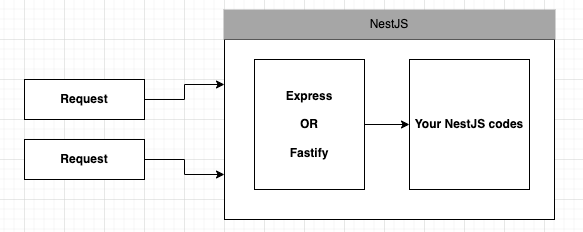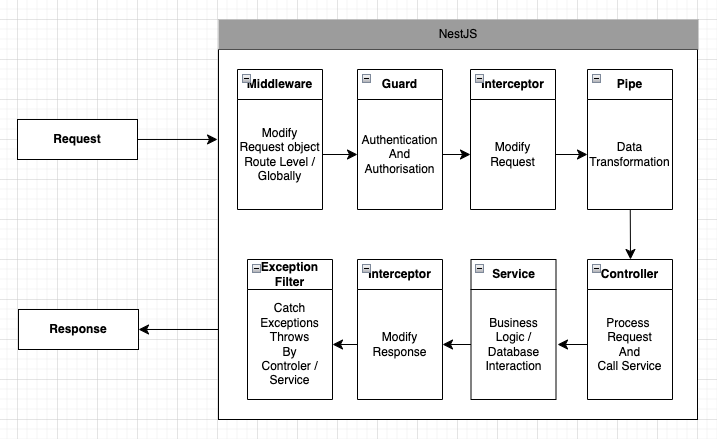Hello Backend devs...
NestJS has quickly become one of the most popular Node.js progressive frameworks for building scalable and maintainable server-side applications. The patterns are followed by Angular's architecture and fully support with TypeScripts. NestJS brings structure and strong typing to the fast-paced world of REST API developments.
If you're coming from Express or a similar minimal framework, starting a NestJS project can feel like a big shift—in a good way. Its modular design, built-in dependency injection, and clear separation of concerns promote clean code and make it easier to scale your application as it grows.
In this guide, I will walk you through the most important concepts you need to know before starting your NestJS project (I am talking about V11.X)
🟢 Main building blocks
- Modules - Group together everything
- Controller - Handle incoming request
- Services - Handle business logic
- Pipes - Validate incoming data
- Exception Filters - Handle errors throws by controller or service
- Guards - Handle authentication and authorisation. Can decide request proceed to not (return true / false)
- Interceptors - Adding extra data to request or to response
- Middleware - Can modify request object
- Repositories - Handle data stored in DB
🟢 The main architecture
NestJS does not handle HTTP request itself. We need to provide either Express OR Fastify for handling HTTP requests. By default, NestJS uses Express.
NestJS main building blocks has an order of execution. See bellow,
🟢 DI Container
NestJS uses dependency injection (DI) as its main design pattern for the easy management of dependencies between application components. NestJS DI system is based on the Inversion of Control (IoC) technique, meaning that the framework controls the creation and life cycle of an objects (such as services and controllers) rather than the objects themselves controlling these aspects.
Basically, NestJS helps with automatically creating and injecting services and other dependencies into classes; hence, one can decouple components and keep the application modular.
🟢 Interceptors
This can be used to modify request and response. Let's say want to modify the request object before it goes to the controller,
Create a new interceptor in the correct module. Eg. modules -> auth -> interceptors -> auth.interceptor.ts
import { CallHandler, ExecutionContext, Injectable, NestInterceptor } from '@nestjs/common';
import { Observable } from 'rxjs';
@Injectable()
export class OAuthInterceptor implements NestInterceptor {
intercept(context: ExecutionContext, next: CallHandler): Observable<any> {
const request = context.switchToHttp().getRequest();
// transform user profile
if (request.user) {
request.user = this.normalizeUserProfile(); // modify user object
}
return next.handle(); // just return the request object without modifying response object
}
}
Note that the return next.handle();. It just pass the request to the controller, no change on response.
Next, call the interceptor from controller,
@UseGuards(AuthGuard('github'))
@UseInterceptors(OAuthInterceptor)
async githubAuthCallback(@Req() req: AuthenticatedRequest, @Res() res: Response) {
if (!req.user) {
throw new UnauthorizedException('User not authorized');
}
}
If it's need to modify the response,
import { CallHandler, ExecutionContext, Injectable, NestInterceptor } from '@nestjs/common';
import { Observable, map } from 'rxjs';
@Injectable()
export class OAuthInterceptor implements NestInterceptor {
intercept(context: ExecutionContext, next: CallHandler): Observable<any> {
const request = context.switchToHttp().getRequest();
// transform user profile
if (request.user) {
request.user = this.normalizeUserProfile(); // modify user object
}
// modify the response also,
return next.handle().pipe(
map((data) => {
return {
success: true, // add anything additional
data,
}
})
);
}
}
🟢 Final Thoughts
It is vital to understand the basic concepts before start any new technologies. It is may be take some time, but, hold on, it would be a good investment for the future. I will update the post with the new finding continuously.
🤝 Let's meet again with setting up NestJS app. Click Here
Cheers... Happy coding!!!




Top comments (0)